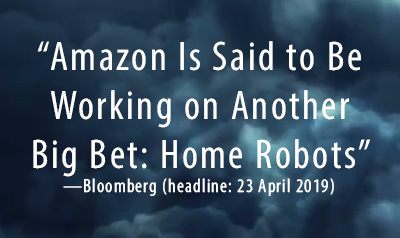
Calling Walt Disney?
Jibo, Kuri, Cozmo: Is This a Trend?
Is Something Stalking Social Robots? Maybe AI, NLP and Alexa?
Does consumer robotics need its own Walt Disney?

“The consumer robot market will be worth about $15 billion a year by 2023,
according to an estimate from Research and Markets, which would be up from about $5.4 billion this year.”
Killer on the loose
Maybe there’s a serial killer on the loose preying on social robots. Bing, bang, boom, three of the most well-known social robots are no more. And just maybe it has something to do with AI? One thing’s for sure, the killings have happened rapidly and in close proximity to the rise of AI.
If there are detectives on the case, they’ve got to be looking for connections among the victims…clues! Millions of dollars have been lost, companies ruined, careers fractured, and all of social robotics is locking its doors and turning off the porch lights.
If we throw in natural-language processing and cheapo household pals like Alexa, we may have on our hands a three-headed serial killer that’s still out there and looking for more victims.
Deep down everyone’s probably thinking the same thought: who’s next?
It has certainly spooked deep-pocketed investors who heretofore staunchly backed social robots with multi-millions of dollars…and tons of confidence. Collectively the investor backing for Jibo, Kuri, and Cozmo is north of a half billion. That shows strong investor belief in the tech, the team, the biz plan, and the market.
Indeed, Jibo, Kuri, and Cozmo did have interesting and valuable tech that has definite customer appeal…and sales. In fact, Anki claims it’s Cozmo and siblings raked in $100 million in 2017. That’s serious money. And all three of these companies were helmed by brilliant robot makers who were passionately dedicated to their robot creations.
Happy investors, happy creators, and an eager marketplace with pent up demand for a live-in social robot should be enough to just about guarantee success. Over 1.5 million Cozmos were scooped up by excited buyers.
What happened to change paradise?
The biggest telltale clue came from Anki CEO and co-founder Boris Sofman: “You cannot sell a robot for $800 or $1,000 that has capabilities of less than an Alexa.” Cozmo sold for $180 bucks a pop, but an Alexa-controlled Echo (2nd generation) sells for $99.99.
“Capabilities less than Alexa” hmmmm.
Amazon, Apple, and Google now have a presence in millions of homes…and are still selling their “smart assistants” briskly. The Amazon, Apple, and Google in-home platforms are now fixed and welcome residents, and all three must be readying for more add-ons. Amazon is said to have Vesta, its own social robot, in the works.
“AI without a body,” adds Yan Fossat, head of the research lab at Toronto-based Klick Health, “has caught on really well. Physical robots, with a body to do something, are not really catching up.” They cost too much for the marginal service they offer, he said.
Did you catch that “marginal service” remark? That’s telling. Look for a social robot that offers “marginal service” and you’re probably looking at the next victim.

“Amazon Is Said to Be Working on Another Big Bet: Home Robots” —Bloomberg (headline: 23 April 2019)
Sadly, a glance through the ranks of social robots shows many. And that list includes the much-ballyhooed Pepper. Think about it. The next-gen Roomba will be smarter than Pepper.
Like Xconomy’s Brian Darling says of Jibo: “Jibo’s demise was accelerated, if not principally caused, by the rise of smart assistants from Google, Amazon, and Apple that offer similar automated speech recognition and search tools to serve up calendar information, music, weather, and more at a fraction of Jibo’s weighty $900 price tag.”
Rich Sadowsky, a Jibo executive, echoes Sofman: “Those [smart assistants] sort of took us by surprise—and not in a happy way.”
Bingo! The stampede to parts unknown by investors is inevitable once they hear AI’s footsteps closing in.

Speak to me…please
To that aforementioned “marginal service” knock, add the fact that none of the three was a language dynamo, and a picture of a social robot with some serious limitations begins to take shape, regardless of each’s obvious cute factor.
Stanford researcher, Clifford Nass, sees voice-user interfaces or VUIs as essential and fundamental for communication between machines and humans, and recent advances in natural-language processing (NLP) have put VUIs within reach. Next stop for VUIs: social robots.
Amazon, Apple, and Google are headed toward VUIs and NLP. NLP researcher, Domingo de Gracia, writes in his recent paper: “The ability of future social and service robots to interact with humans in natural ways will depend mainly on developing capabilities of humanlike dialogue-based natural-language processing (NLP) in robotic architectures.” All of which seems so logical, if after all, we believe that speech is the fundamental means of human communication. Jibo, Kuri, and Cozmo, products of more than a few years back, were born without an advanced NLP skillset. If Jibo, Kuri, and Cozmo were products from 2018, they’d definitely possess those skills. But they don’t.
Are Jibo, Kuri, and Cozmo now more like a branch of robot evolution headed for extinction, while robot evolution’s mainstream takes a new turn? Sure looks that way. VUIs use speech recognition technology to enable users to interact with technology using just their voices, and that alas, is where social robotics is headed.
Roboticist Guy Hoffman predicts “that when designers will start their own social robotics companies and hire engineers, rather than the other way around, we will finally discover what the hidden need for home robots was in the first place.”
Then just maybe what social robotics really needs is its very own Walt Disney.
